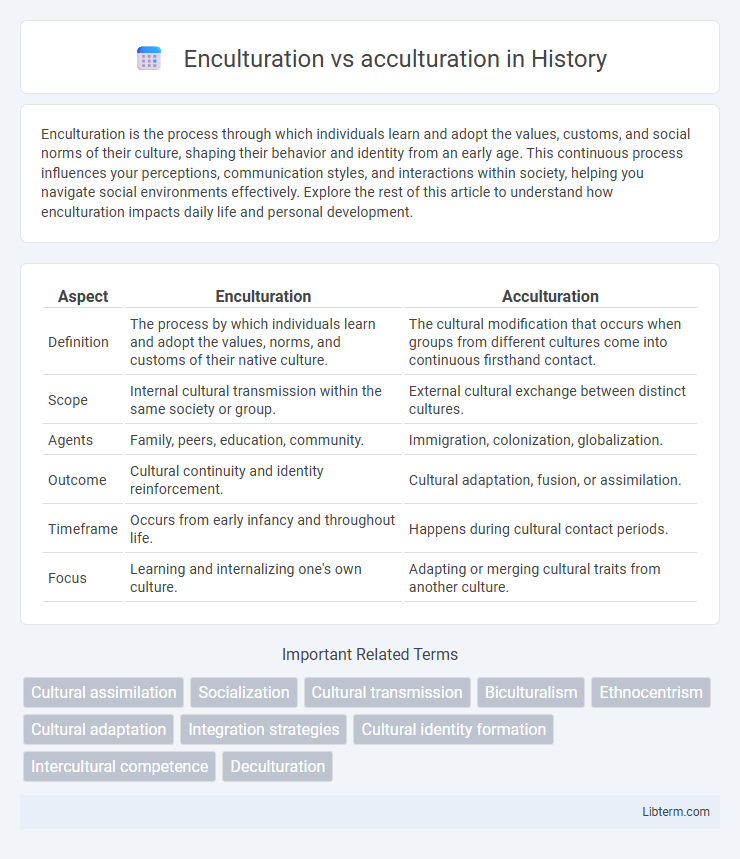Enculturation is the process through which individuals learn and adopt the values, customs, and social norms of their culture, shaping their behavior and identity from an early age. This continuous process influences your perceptions, communication styles, and interactions within society, helping you navigate social environments effectively. Explore the rest of this article to understand how enculturation impacts daily life and personal development.
Table of Comparison
| Aspect | Enculturation | Acculturation |
|---|---|---|
| Definition | The process by which individuals learn and adopt the values, norms, and customs of their native culture. | The cultural modification that occurs when groups from different cultures come into continuous firsthand contact. |
| Scope | Internal cultural transmission within the same society or group. | External cultural exchange between distinct cultures. |
| Agents | Family, peers, education, community. | Immigration, colonization, globalization. |
| Outcome | Cultural continuity and identity reinforcement. | Cultural adaptation, fusion, or assimilation. |
| Timeframe | Occurs from early infancy and throughout life. | Happens during cultural contact periods. |
| Focus | Learning and internalizing one's own culture. | Adapting or merging cultural traits from another culture. |
Introduction to Enculturation and Acculturation
Enculturation is the process by which individuals learn and adopt the values, customs, language, and norms of their native culture, shaping their identity from early childhood. Acculturation occurs when individuals encounter a new or dominant culture, leading to the adaptation or blending of cultural traits through prolonged contact and social interaction. Understanding these processes is essential for analyzing how cultures evolve and how individuals navigate cultural boundaries.
Defining Enculturation
Enculturation is the process by which individuals learn and adopt the values, customs, beliefs, and social norms of their native culture, typically occurring during childhood through family and community interactions. It involves internalizing cultural knowledge essential for functioning effectively within one's original cultural environment. This process contrasts with acculturation, which refers to adapting to a new or different culture when encountering foreign cultural influences.
Defining Acculturation
Acculturation refers to the process through which individuals or groups adopt cultural traits, values, or behaviors from another dominant culture, often occurring when different cultures come into direct contact. Unlike enculturation, which is the lifelong process of learning one's native culture, acculturation involves adapting to cultural changes resulting from social interactions, migration, or colonization. This process can include alterations in language, customs, and social norms, leading to varying degrees of cultural assimilation or integration.
Key Differences Between Enculturation and Acculturation
Enculturation is the process through which individuals learn and adopt the values, customs, and norms of their native culture from birth, shaping their identity within their original society. Acculturation occurs when individuals or groups from different cultures interact, leading to the adoption or adaptation of cultural traits from the dominant society, often seen in immigrant populations. Key differences include the source of cultural learning--enculturation is immersed within the native culture, while acculturation involves cross-cultural exchange and integration, resulting in varying degrees of cultural change and identity negotiation.
Processes Involved in Enculturation
Enculturation involves the gradual process by which individuals learn and internalize the values, customs, language, and social norms of their native culture through direct interaction with family, peers, and community. This process includes observational learning, imitation, and participation in cultural rituals and daily activities that reinforce shared beliefs and identity. Unlike acculturation, which entails adapting to a new culture, enculturation is foundational for transmitting cultural continuity within a society.
Mechanisms of Acculturation
Mechanisms of acculturation include assimilation, integration, separation, and marginalization, which describe how individuals or groups adapt to a new culture while balancing their original cultural identity. Acculturation often occurs through processes such as socialization, adaptation, and cultural exchange, involving language acquisition, adoption of social norms, and participation in cultural practices. These mechanisms influence psychological adjustment, social integration, and identity formation within multicultural environments.
Impacts on Individual and Group Identity
Enculturation shapes individual identity by instilling native cultural values, beliefs, and practices from early childhood, fostering a strong sense of belonging within the original cultural group. Acculturation influences both individual and group identity by blending or modifying cultural traits when individuals or groups come into contact with different cultures, potentially leading to cultural adaptation, integration, or identity conflict. The degree of cultural preservation or change during acculturation impacts social cohesion, psychological well-being, and the maintenance of cultural heritage within multicultural societies.
Examples of Enculturation in Daily Life
Children learning their family's language and traditions at home exemplify enculturation, as they absorb cultural norms from their immediate environment. Participating in community festivals and religious ceremonies reinforces cultural values through direct experience. Daily interactions, such as observing customary greetings and dining practices, further embed cultural knowledge and identity.
Case Studies of Acculturation Across Cultures
Case studies of acculturation across cultures reveal diverse adaptation processes influenced by factors such as cultural distance, socioeconomic status, and community support. Research in immigrant populations illustrates varying degrees of cultural retention and assimilation, highlighting models like Berry's bidimensional framework distinguishing integration, assimilation, separation, and marginalization. For instance, studies among Hispanic immigrants in the United States show that integration strategies foster better psychological well-being and social functioning compared to separation or marginalization approaches.
The Role of Enculturation and Acculturation in Globalization
Enculturation shapes individuals by transmitting cultural values and practices within their native society, ensuring cultural continuity in a rapidly globalizing world. Acculturation involves adapting to and integrating elements from different cultures, facilitating intercultural exchange and social cohesion across diverse populations. Both processes play crucial roles in globalization by balancing cultural preservation with innovation and cross-cultural understanding.
Enculturation Infographic

 libterm.com
libterm.com